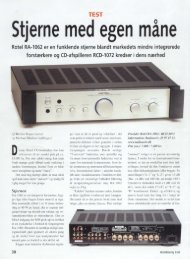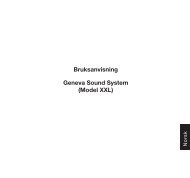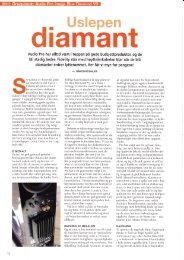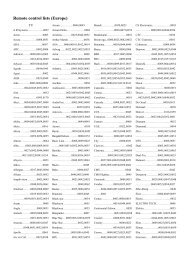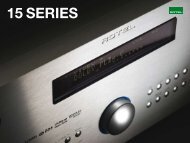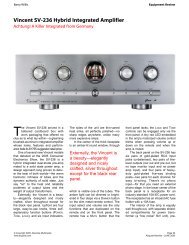Feature Subwoofers 2 - Neby Hi-Fi Concept AS
Feature Subwoofers 2 - Neby Hi-Fi Concept AS
Feature Subwoofers 2 - Neby Hi-Fi Concept AS
Create successful ePaper yourself
Turn your PDF publications into a flip-book with our unique Google optimized e-Paper software.
g r o u p t e s t / s u b w o o f e r s<br />
26 august / september 2005 >>FFWD<br />
Shake!<br />
A quality subwoofer adds being-there<br />
sophistication to a bass line, and chestshuddering<br />
realism to Vin Diesel’s latest<br />
car crash. Scott Bartley rates four of<br />
the best from $999.
How we test<br />
g r o u p t e s t / s u b w o o f e r s<br />
Reviewing subwoofers, much like any other speaker, is<br />
a notoriously difficult affair. <strong>Fi</strong>rstly and most obviously,<br />
the person doing the review has their own tastes and<br />
preferences. Secondly, the room in which the review<br />
is being performed plays an important role in how a<br />
subwoofer sounds. Whenever we test a subwoofer here<br />
at >>FFWD we find that the quickest and easiest way to<br />
test its mettle is to use it in a two-channel music setup.<br />
It gives an immediate impression of its performance<br />
capabilities when using selections of familiar music. A<br />
selection of DVD movies we know well are used in a 5.1<br />
setup to test bass response in home theatre guise and<br />
a switch box is used to perform simple a/b comparisons<br />
between units. We also use test tones at specific<br />
frequencies and measure room-sound pressure levels<br />
using an SPL (sound pressure level) meter — a gadget<br />
that, when pointed at a subwoofer, measures sound<br />
levels in decibels.<br />
What we used:<br />
AMPLIFIER: Denon AVC-A1XV<br />
DVD PLAYER: Denon DVD-A1XV<br />
DVDS: Saving Private Ryan, The Incredibles,<br />
Black Hawk Down, Blade: Trinity<br />
CDS: Lisa Ekdahl: Back To Earth, Cincinnati<br />
Symphony Orchestra: Tchaikovsky 1812<br />
Overture, Stereophile Test CD<br />
S<br />
ubwoofers mean different things to different people.<br />
To a boy racer it means being able to make various<br />
panels on a car (and those around it) vibrate excessively<br />
for the least amount of money possible. To a<br />
home theatre enthusiast it means nuclear explosions<br />
in your lounge, while to audiophiles it means being able<br />
to hear the weight behind a bass drum in a concert hall.<br />
That’s a lot to ask from a single piece of home audio equipment.<br />
Because we’re >>FFWD and actually care about quality in audio<br />
reproduction, we’ll forget about those boy racers and leave them to<br />
their $99 subs from the big red sheds. Instead, we’ll take a look at<br />
proper subwoofers designed for use in the home, and, because we’re<br />
not all made of money (sadly), we’ll limit the contenders to a maximum<br />
retail price of $1,700.<br />
NOT ALL SUBWOOFERS ARE CREATED EQUAL<br />
Why would someone want to spend $1,000-plus on a sub when they<br />
can buy one with the ‘same’ specs for less than half the price from<br />
their local appliance store? Well, the popular misconception that subwoofers<br />
are boom boxes where only raw wattage counts is a myth that<br />
we’d quite like to dispel. We’re not going to tell you you need to spend<br />
thousands on something that’s as big as a fridge but we implore you<br />
to spend more than a few hundred dollars on the cheapest 1,500W<br />
mega-box you can find. A quality sub makes a staggering difference<br />
to bass reproduction and is an essential part of any home theatre or<br />
hi-fi system worth its salt.<br />
>>FFWD august / september 2005 27
g r o u p t e s t / s u b w o o f e r s<br />
TYPE: 175W bass reflex<br />
WOOFER: 8-inch<br />
FREQUENCY RANGE:<br />
27–100Hz<br />
DIMENSIONS (W/H/D):<br />
320 x 385 x 355mm<br />
WEIGHT: 16.8kg<br />
CONTACT: Viganoni and<br />
Viganoni, 09-473 2099,<br />
www.audiopro.com<br />
28 august / september 2005 >>FFWD<br />
WHAT’S THE DIFFERENCE?<br />
It’s all about distortion when it comes to subwoofers and a great<br />
many people mistake distortion for bass. However, it’s an easy<br />
mistake to make, and until you’ve heard a really good subwoofer<br />
in operation it’s one that will probably never be rectified. You could<br />
well blast away for years never knowing what you’re missing out<br />
on. This is where group tests such as this play an important role (to<br />
the chagrin of many a vendor) since a subwoofer that, objectively<br />
speaking, sounded pretty good before, can suddenly sound a<br />
Audio Pro Sub B1.28 — $1,499<br />
W<br />
e’ve yet to hear a speaker or subwoofer from Swedish<br />
manufacturer Audio Pro that hasn’t performed beyond<br />
our expectations, and this one is no exception.<br />
The B1.28 is a small unit when stood next to the other<br />
competitors in this roundup and yet it somehow manages to<br />
sound much larger than it actually is — it’s a perfect choice for<br />
small and medium-sized rooms.<br />
The black, high-gloss finish is utterly superb and is easily<br />
the most impressive of the contenders in the test. It encloses<br />
an 8-inch, front-firing (forward facing), long-throw woofer that<br />
is powered by a 175W ace-bass amplifier. The entire unit is<br />
little pale when compared directly to a superior unit.<br />
True deep bass is different to a one-note, floor-shaking rumble<br />
filled with distortion. Bass should have weight to it and should<br />
appear to roll smoothly out of the subwoofer, through the floor, to<br />
your feet and up through your body. It should make a huge classical<br />
bass drum with an indefinite pitch sound three feet wide, yet<br />
it must also convey the great variations in frequency of a double<br />
bass. And that’s before we’ve even started with the DVD movies<br />
a subwoofer must cope with.<br />
of a bass reflex design with a down-firing (downward facing)<br />
port.<br />
The ‘ace-bass’ technology we mention here is more than<br />
just a marketing gimmick; it’s actually a patented technology<br />
Audio Pro invented back in 1978. It stands for amplifier<br />
controlled euphonic bass and uses a complex mathematical<br />
equation that equalises all resistances within the loudspeaker<br />
with almost no distortion. We won’t even pretend to understand<br />
how it works but the net result is deep bass without the need<br />
for large woofers (by that we mean over 12 inches) and even<br />
larger enclosures. The ace-bass really works some magic here.<br />
And boy if it isn’t ever the Harry Potter of the subwoofer world<br />
— this tiny sub produces some prodigious bass.<br />
Using test tones at the lower end of the scale, we measured<br />
the output with an SPL meter and the B1.28 was the only sub<br />
to produce useable bass at the 25Hz and 20Hz levels. This is<br />
a perfect example of why you should never trust specification<br />
boxes from manufacturers. Audio Pro lists a flat frequency<br />
response of 27–100Hz (what we’d call a true reading, meaning<br />
it measures flat to 27Hz then starts to roll off) while others list<br />
frequency response as low as 19Hz. This may appear better<br />
than the Audio Pro on paper, but in reality that 19Hz measurement<br />
is so low it’s almost inaudible.<br />
Test tones aside, the B1.28 was musically unmatched for<br />
two reasons. <strong>Fi</strong>rstly, bass response was so incredibly tight and<br />
deep it really must be heard to be believed, especially from<br />
such a small box. And secondly, it integrated so sweetly with<br />
the mains that it simply blended into the mix so we weren’t sure<br />
exactly when the main speakers rolled off and the subwoofer<br />
took over — the ultimate goal of any subwoofer designer.<br />
In straight a/b comparisons of fast-paced tracks with deep<br />
bass, the B1.28 produced sound with real weight to it. From<br />
Lynyrd Skynyrd’s punchy ‘Kiss Your Freedom Goodbye’ to<br />
a fantastic Telarc recording of the 1812 Overture to Saving<br />
Private Ryan’s second chapter, the B1.28’s performance was<br />
breathtaking.<br />
It’s small, easy to place, has a full complement of line-level<br />
and speaker-level inputs and outputs and what’s more, it’s a<br />
bargain at $1,499.
Energy S12.3 — $1,699<br />
he first of two subwoofers tested here to come out of<br />
T Canadian Audio Products International is the Energy<br />
S12.3. We didn’t intentionally set out to gather two similar<br />
subs from the same parent company (they’re distributed<br />
by different companies here in New Zealand), it just kind of<br />
happened. It wasn’t until they were unpacked, plugged in<br />
and calibrated that we noticed distinct similarities between<br />
this one and the Mirage.<br />
The black ash veneer looks all but identical, although the<br />
Mirage seems to have had a little more care taken during its<br />
application to the MDF (medium density fibreboard) chassis as<br />
the Energy has a few glue splotches around the joins. It’s all<br />
but unnoticeable, however, unless you’re up close inspecting<br />
it as we were.<br />
Volume control is handily placed on the front panel while all<br />
other controls, including variable low pass filter (50Hz–110Hz),<br />
line level input and stereo high-level inputs for speaker level<br />
connection options, are on the back. The low pass filter can<br />
be switched off completely, letting a suitably equipped receiver<br />
or processor handle the crossover workload if you prefer. The<br />
S12.3 features an auto-off function (as do all the subwoofers in<br />
the group test) that puts the sub into standby mode if it hasn’t<br />
received a signal after a few minutes.<br />
The woofers in both the Energy and the Mirage, although<br />
different sizes, look to be cut from the same cloth and they even<br />
use the same patented ‘Ribbed Elliptical Surround’ technology<br />
— said to decrease distortion from high-excursion drivers.<br />
According to the website (the two-page manual was no help),<br />
the Elliptical Surround will “increase excursion, eliminate surround<br />
distortion and raise efficiency”. The little ribs eliminate<br />
dimpling in the material surrounding the woofer which Mirage<br />
says enables the S12.3 to “play lower with greater output fidelity<br />
than the competition”. Bold claims indeed.<br />
The 12-inch, front-facing woofer with a down-firing bass<br />
reflex port is easily the largest in our test and, as such, produces<br />
a satisfyingly ‘big’ sound, thanks to a 300W amplifier. Even so, it<br />
doesn’t go as deep in our test environment as the specifications<br />
THE S12.3 IS A BIG, BR<strong>AS</strong>H<br />
SUBWOOFER THAT LIKES TO<br />
RUMBLE ITS WAY INTO YOUR<br />
HEART WITH SLAM-AND-BANG<br />
EFFECTS. BUT IT LACKS THE<br />
SPEED TO DEFINE F<strong>AS</strong>T-PACED<br />
B<strong>AS</strong>S EFFECTS, WHETHER IT BE<br />
B<strong>AS</strong>S DRUM OR MACHINE GUN.<br />
claim and we think the 19Hz +/-3dB rating may be an unrealistic<br />
measurement taken from an anechoic chamber (an accoustically<br />
dead room with no echoes). Running a 20Hz test tone saw<br />
a drop in SPL of 15dB from the previous 25Hz measurement,<br />
making the bass all but inaudible at reference volume.<br />
During our real-world listening tests we found it most enjoyable<br />
in its guise as a home theatre sub, as opposed to when<br />
it was being used to listen to music. Why is this? The S12.3 is<br />
a big, brash subwoofer that likes to rumble its way into your<br />
heart with slam-and-bang effects. But it lacks the speed to<br />
define fast-paced bass effects, whether it be bass drum or<br />
machine gun. This meant the low end tended to meld together<br />
at a time when music and movies were crying out for clearly<br />
defined kick-drum beats or gun-fire with distinction between<br />
shots. For the most part, this kind of behaviour is forgivable<br />
during movie playback, since even though you miss out on<br />
detail you still get the impressive impact of the action onscreen.<br />
Music, which relies completely on your aural sensibilities, suffers<br />
at the hands of the S12.3. Like we said earlier, you may not<br />
realise this if you’ve not heard a better subwoofer reproducing<br />
the same track.<br />
g r o u p t e s t / s u b w o o f e r s<br />
TYPE: 300W bass reflex<br />
WOOFER: 12-inch<br />
FREQUENCY RANGE:<br />
19–120Hz (+/- 3dB)<br />
DIMENSIONS (W/H/D):<br />
418 x 490 x 465mm<br />
WEIGHT: 21.3kg<br />
CONTACT: Audio Products,<br />
09-443 3302, www.energyspeakers.com<br />
>>FFWD august / september 2005 29
g r o u p t e s t / s u b w o o f e r s<br />
TYPE: 200W bass reflex<br />
WOOFER: 10-inch<br />
FREQUENCY RANGE:<br />
21–120Hz (+/- 3dB)<br />
DIMENSIONS (W/H/D):<br />
373 x 431 x 469mm<br />
WEIGHT: 18.6kg<br />
CONTACT: Denco Audio,<br />
03-379 0743, www.miragespeakers.com<br />
30 august / september 2005 >>FFWD<br />
Mirage Omni S10 — $1,099<br />
W<br />
e’ve already discussed the similarities between this<br />
sub and its first cousin from Energy, and despite<br />
the smaller 10-inch woofer in the Mirage, they do look very<br />
alike. The Omni S10 uses the same black ash veneer but<br />
it differs in cabinet construction, thanks to some smartlooking<br />
bevelled edges. Volume control is located on the<br />
front panel, but unlike the Energy the variable crossover is<br />
included along with two switches for phase adjustment and<br />
to turn off the built-in crossover. It’s all hidden away under<br />
the black cloth grille, which is great for both aesthetic and<br />
practical reasons. While it’s handy to have these controls on<br />
the front, anyone with small children will soon find the levels<br />
they spent hours getting just right have been mindlessly<br />
altered by their three-year-old who cares not for perfect<br />
bass response. <strong>Hi</strong>ding the controls under the grille keeps<br />
them handy for you, but not your offspring.<br />
On the back panel we find the rest of the controls, which<br />
include line level and speaker level ins and outs.<br />
The 10-inch woofer is front firing, made of the same<br />
silver/black coloured material as the Energy and powered<br />
by a 200W built-in amplifier. The Ribbed Elliptical Surround<br />
is used also, so it’s only sensible we delve a little deeper<br />
into why this Canadian company has developed it. It gives<br />
the woofer a greater ‘peak-to-peak’ range of movement<br />
and Mirage claims that this movement is more than double<br />
that of its competitors. Greater movement in this manner<br />
means it can move more air and the non-dimpling Elliptical<br />
Surround means it doesn’t result in the distortion typical of<br />
such high-excursion drivers.<br />
Mirage states the frequency range as 21–120Hz at +/-3dB.<br />
Again, we suspect this to be an anechoic measurement,<br />
since the Omni S10 certainly didn’t go as deep as the Audio<br />
Pro and in our SPL measurement tests it fell away sharply<br />
below 25Hz. In its favour, however, is the 10-inch driver,<br />
which is far more agile than the 12-incher in the Energy,<br />
making it more responsive to fast-paced action scenes or<br />
music tracks. Still, we suspect the very thing Mirage touts<br />
as a breakthrough technology (the Elliptical Surround) is<br />
holding it back in some respects. The extra movement of<br />
the woofer slows it down and again we found bass sounds<br />
tended to blur together whenever speed was called for in<br />
audio reproduction.<br />
Bass from the Omni simply didn’t carry as much weight<br />
as the Audio Pro, despite producing results in our SPL tests<br />
that were pretty decent unto themselves. At $1,099 (or<br />
$999, if you shop around) it is the least expensive of all the<br />
contenders by a substantial margin, but somehow the little<br />
Audio Pro subwoofer still leads the way in this group test.<br />
Can the Wharfedale fare any better? Read on.<br />
AT $1,099 IT IS THE LE<strong>AS</strong>T<br />
EXPENSIVE OF ALL THE<br />
CONTENDERS BY A SUBSTANTIAL<br />
MARGIN, BUT SOMEHOW THE<br />
LITTLE AUDIO PRO SUBWOOFER<br />
STILL LEADS THE WAY IN THIS<br />
GROUP TEST.
Wharfedale SW250R — $1,299<br />
ood old British engineering. If you believe the guys on Top<br />
G Gear, who stubbornly refuse to accept that British-made<br />
cars aren’t the be-all and end-all of the automotive world, you<br />
might think this subwoofer unbeatable also. Turns out it is<br />
beatable and, much to the disdain of Jeremy Clarkson et al, it’s<br />
been beaten by the Swedes — that’s right, the same people<br />
who gave the world Volvo and Abba. But we’re getting ahead<br />
of ourselves, first let’s see what the Brits have to offer us.<br />
The SW250R is a medium-sized subwoofer (though not<br />
quite as big as the Energy S12.3) that opts for a non-conventional<br />
curved cabinet. It’s also the heaviest in the group test<br />
but we’re not sure by how much because Wharfedale, the<br />
modest company it is, doesn’t list the weight in any documentation<br />
or on its website. At a guess, it feels somewhere<br />
around the 25kg mark. A quick knuckle rap test confirmed<br />
the solidity and gave a satisfying dull thud, as opposed<br />
to the somewhat echoey hollow sound of the Mirage and<br />
Energy subs (the Audio Pro, like Wharfedale, also sounded<br />
reassuringly solid).<br />
The vinyl veneer looks great and as for controls, well, there<br />
aren’t any. Not on the subwoofer at least. It’s all electronically<br />
controlled via remote. This is particularly handy because<br />
you can store four different volume/crossover settings in<br />
memory. You could have one setting for movies, one for TV,<br />
one for music at low volume and one for music played loud.<br />
The remote lets you make all adjustments from your listening<br />
position — no more running back and forth from your chair to<br />
the sub making fine adjustments while reaching around the<br />
back of the thing. The variable crossover is a little frustrating<br />
if you like absolute control over your bass, because instead<br />
of being able to set the crossover exactly there are but six<br />
presets ranging from 85Hz to 35Hz. Thankfully, this can be<br />
g r o u p t e s t / s u b w o o f e r s<br />
THE REMOTE<br />
LETS YOU<br />
MAKE ALL<br />
ADJUSTMENTS<br />
FROM YOUR<br />
LISTENING<br />
POSITION — NO<br />
MORE RUNNING<br />
BACK AND<br />
FORTH FROM<br />
YOUR CHAIR<br />
TO THE SUB<br />
MAKING FINE<br />
ADJUSTMENTS.<br />
>>FFWD august / september 2005 31
g r o u p t e s t / s u b w o o f e r s<br />
32 august / september 2005 >>FFWD
TYPE: 250W sealed box<br />
WOOFER: 10-inch<br />
FREQUENCY RANGE:<br />
30–110Hz<br />
DIMENSIONS (W/H/D):<br />
420 x 420 x 375mm<br />
WEIGHT: 25kg (approx)<br />
CONTACT: Monaco, 09-<br />
415 6000, www.wharfedale.<br />
co.nz<br />
turned off to use a receiver’s bass management instead.<br />
The SW250R uses a 10-inch down-firing driver in a sealed<br />
box design — the only sub in the group to do so. Sealed-box<br />
subwoofers have no bass port to allow air to move along with<br />
the driver, a system that, in theory, provides tighter bass with<br />
greater control than bass reflex subs, but generally requires<br />
substantially more amplifier power in return (the SW250R has<br />
a 250W amp). However, as we’ve discovered with the Audio<br />
Pro B1.28, fast bass can be achieved by other means using<br />
a less power-hungry amp.<br />
The SW250R’s frequency response is 30–110Hz which is,<br />
on paper, the worst of the bunch. Don’t forget, though, that<br />
the two Canadians seem a little optimistic with their specs.<br />
Indeed, our SPL tests showed almost nothing at 25Hz but<br />
plenty of volume at 31.5Hz.<br />
In practice the Wharfedale provided the second-best<br />
bass response in the group. It was able to blend seamlessly<br />
with the mains, go loud with little distortion and was deep<br />
enough and fast enough to satisfy movie lovers. Music lovers,<br />
on the other hand, will prefer the even deeper bass of the true<br />
performer in this roundup, the Audio Pro B1.28.<br />
scott_bartley@idg.co.nz<br />
g r o u p t e s t / s u b w o o f e r s<br />
>>FFWD august / september 2005 33




